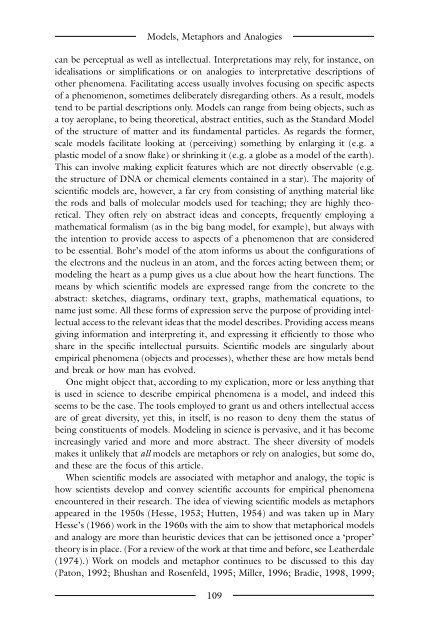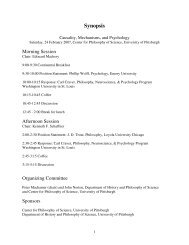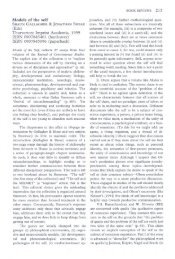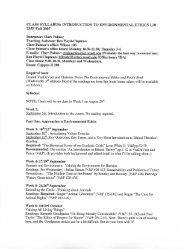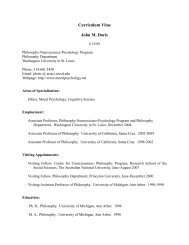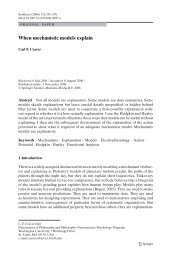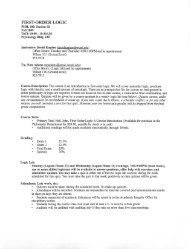The Blackwell Guide to the Philosophy of Science - The Department ...
The Blackwell Guide to the Philosophy of Science - The Department ...
The Blackwell Guide to the Philosophy of Science - The Department ...
Create successful ePaper yourself
Turn your PDF publications into a flip-book with our unique Google optimized e-Paper software.
Models, Metaphors and Analogies<br />
can be perceptual as well as intellectual. Interpretations may rely, for instance, on<br />
idealisations or simplifications or on analogies <strong>to</strong> interpretative descriptions <strong>of</strong><br />
o<strong>the</strong>r phenomena. Facilitating access usually involves focusing on specific aspects<br />
<strong>of</strong> a phenomenon, sometimes deliberately disregarding o<strong>the</strong>rs. As a result, models<br />
tend <strong>to</strong> be partial descriptions only. Models can range from being objects, such as<br />
a <strong>to</strong>y aeroplane, <strong>to</strong> being <strong>the</strong>oretical, abstract entities, such as <strong>the</strong> Standard Model<br />
<strong>of</strong> <strong>the</strong> structure <strong>of</strong> matter and its fundamental particles. As regards <strong>the</strong> former,<br />
scale models facilitate looking at (perceiving) something by enlarging it (e.g. a<br />
plastic model <strong>of</strong> a snow flake) or shrinking it (e.g. a globe as a model <strong>of</strong> <strong>the</strong> earth).<br />
This can involve making explicit features which are not directly observable (e.g.<br />
<strong>the</strong> structure <strong>of</strong> DNA or chemical elements contained in a star). <strong>The</strong> majority <strong>of</strong><br />
scientific models are, however, a far cry from consisting <strong>of</strong> anything material like<br />
<strong>the</strong> rods and balls <strong>of</strong> molecular models used for teaching; <strong>the</strong>y are highly <strong>the</strong>oretical.<br />
<strong>The</strong>y <strong>of</strong>ten rely on abstract ideas and concepts, frequently employing a<br />
ma<strong>the</strong>matical formalism (as in <strong>the</strong> big bang model, for example), but always with<br />
<strong>the</strong> intention <strong>to</strong> provide access <strong>to</strong> aspects <strong>of</strong> a phenomenon that are considered<br />
<strong>to</strong> be essential. Bohr’s model <strong>of</strong> <strong>the</strong> a<strong>to</strong>m informs us about <strong>the</strong> configurations <strong>of</strong><br />
<strong>the</strong> electrons and <strong>the</strong> nucleus in an a<strong>to</strong>m, and <strong>the</strong> forces acting between <strong>the</strong>m; or<br />
modeling <strong>the</strong> heart as a pump gives us a clue about how <strong>the</strong> heart functions. <strong>The</strong><br />
means by which scientific models are expressed range from <strong>the</strong> concrete <strong>to</strong> <strong>the</strong><br />
abstract: sketches, diagrams, ordinary text, graphs, ma<strong>the</strong>matical equations, <strong>to</strong><br />
name just some. All <strong>the</strong>se forms <strong>of</strong> expression serve <strong>the</strong> purpose <strong>of</strong> providing intellectual<br />
access <strong>to</strong> <strong>the</strong> relevant ideas that <strong>the</strong> model describes. Providing access means<br />
giving information and interpreting it, and expressing it efficiently <strong>to</strong> those who<br />
share in <strong>the</strong> specific intellectual pursuits. Scientific models are singularly about<br />
empirical phenomena (objects and processes), whe<strong>the</strong>r <strong>the</strong>se are how metals bend<br />
and break or how man has evolved.<br />
One might object that, according <strong>to</strong> my explication, more or less anything that<br />
is used in science <strong>to</strong> describe empirical phenomena is a model, and indeed this<br />
seems <strong>to</strong> be <strong>the</strong> case. <strong>The</strong> <strong>to</strong>ols employed <strong>to</strong> grant us and o<strong>the</strong>rs intellectual access<br />
are <strong>of</strong> great diversity, yet this, in itself, is no reason <strong>to</strong> deny <strong>the</strong>m <strong>the</strong> status <strong>of</strong><br />
being constituents <strong>of</strong> models. Modeling in science is pervasive, and it has become<br />
increasingly varied and more and more abstract. <strong>The</strong> sheer diversity <strong>of</strong> models<br />
makes it unlikely that all models are metaphors or rely on analogies, but some do,<br />
and <strong>the</strong>se are <strong>the</strong> focus <strong>of</strong> this article.<br />
When scientific models are associated with metaphor and analogy, <strong>the</strong> <strong>to</strong>pic is<br />
how scientists develop and convey scientific accounts for empirical phenomena<br />
encountered in <strong>the</strong>ir research. <strong>The</strong> idea <strong>of</strong> viewing scientific models as metaphors<br />
appeared in <strong>the</strong> 1950s (Hesse, 1953; Hutten, 1954) and was taken up in Mary<br />
Hesse’s (1966) work in <strong>the</strong> 1960s with <strong>the</strong> aim <strong>to</strong> show that metaphorical models<br />
and analogy are more than heuristic devices that can be jettisoned once a ‘proper’<br />
<strong>the</strong>ory is in place. (For a review <strong>of</strong> <strong>the</strong> work at that time and before, see Lea<strong>the</strong>rdale<br />
(1974).) Work on models and metaphor continues <strong>to</strong> be discussed <strong>to</strong> this day<br />
(Pa<strong>to</strong>n, 1992; Bhushan and Rosenfeld, 1995; Miller, 1996; Bradie, 1998, 1999;<br />
109


